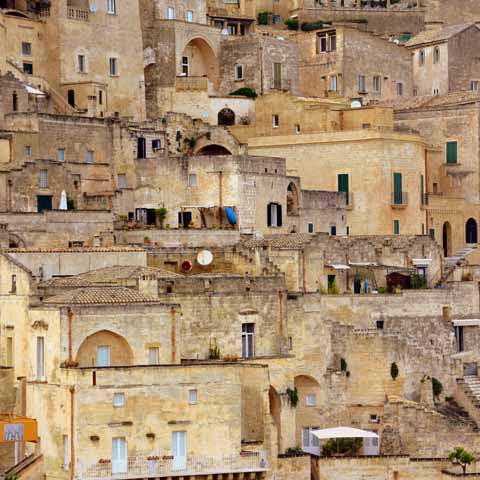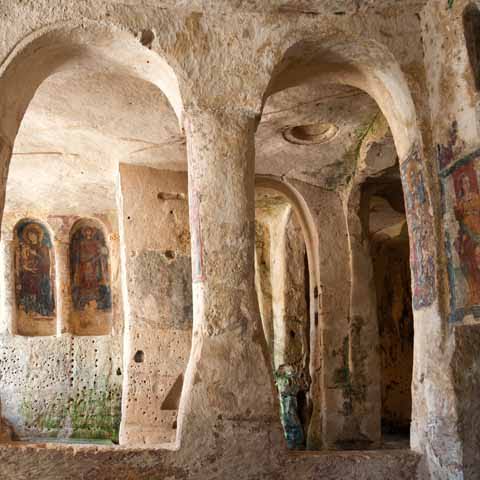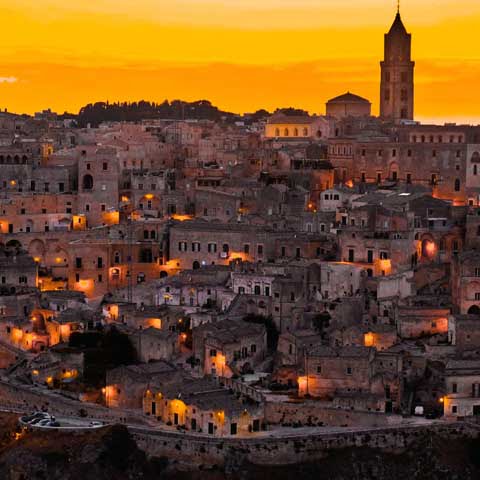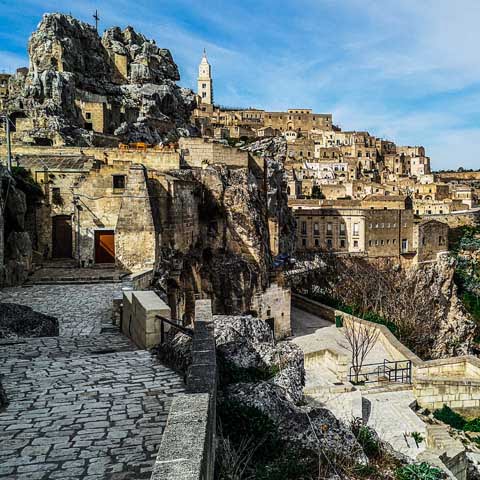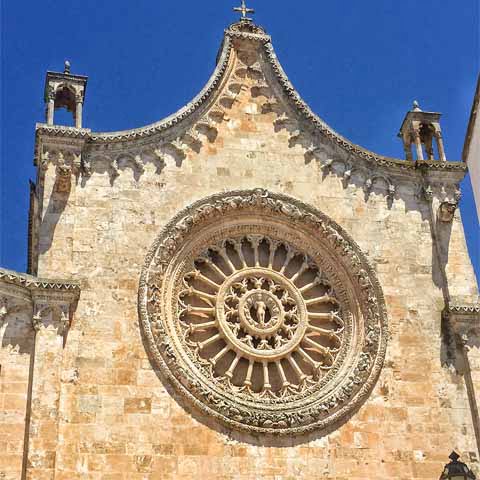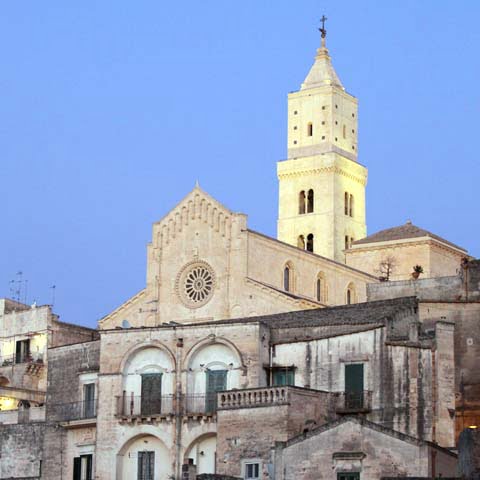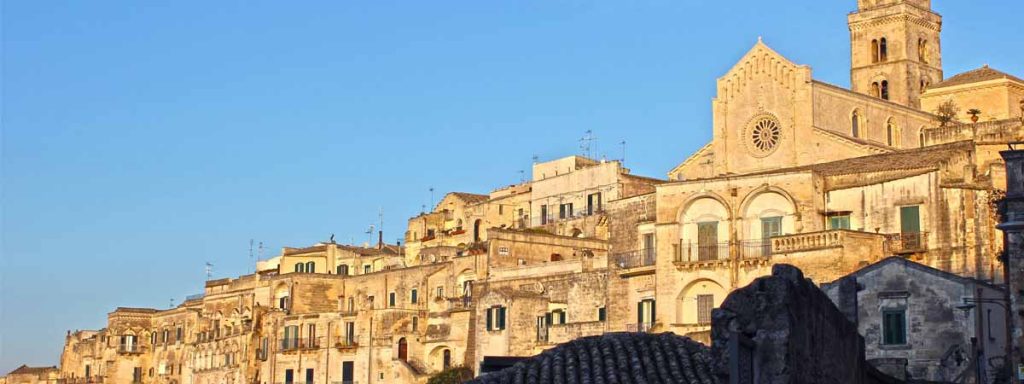The remote area of Matera located in Southern Italy in the region of Basilicata is home to ancient architecture and art history, coupled with a past and present in the field of cinematography. The rock city of Matera is quietly thriving with culture. The history and tradition of this city are tucked away into the far rocky corners of the ancient churches and museums of the Sassi that captivate the imaginations of all who visit.
ARCHITECTURE
The Sassi, Matera’s historical center, is home to a dozen or more rock churches that were beautifully designed to be a part of the rock the city is built into. Each church is unique in its façade, interior, and treasures it houses within.
The Church of Madonna delle Virtù and Church of San Nicola dei Greci together make up a monastic complex, where monks and nuns once lived under devout religious vows. The Church of Madonna delle Virtù was built circa the tenth or eleventh century, but was restored in the seventeenth century. Sitting directly above it is the Church of San Nicola dei Greci, a complex used in the thirteenth century by Benedictine monks. A tour of these sacred chambers carved into the limestone reveals beautiful and ancient religious frescoes.
One of Matera’s largest rupestrian churches is the Church of San Pietro Barisano. The structure is a twelfth century church with a Romanesque-Baroque style exterior. The inside of the church is dug directly into the rock and features eight altars, a series of intricate frescoes, and a crypt.
The ancient Monastery of Santa Lucia alle Malve is a cliff-faced church that was home to Benedictine nuns sometime before or during the sixteenth century. Beautiful mural paintings and frescoes estimated to be from the thirteenth century still exist on the archways and walls with representations of Saint Michael the Archangel, Saint Benedict, the Nursing Madonna, and Saint Gregory.
The Convent of Sant’Agostino is another monastic complex from the sixteenth century said to have been built by the monks of the Order of the Emeritus of St. Augustine. The late Baroque architecture of the exterior is stunning, with an intricate statue of Saint Augustine and a tall bell tower. The interior of the structure is home to an eighteenth-century organ, a stone baptismal font, and a well-known painting of the Madonna with child.
The Church of San Pietro e Paolo al Caveoso is the only church in the Sassi not considered a rock church. It is estimated to have been built in the early thirteenth century. The Baroque façade is simply stunning, with stone arches and a rose window giving it a much newer appearance than many of its rock-cut counterparts. The church also features a square-based bell tower that dates back to the seventeenth century. The interior of the church is home to four different chapels, seventeenth century frescoes of saints, and part of a wooden relief, or sculpture, from the sixteenth century.
Another church with a beautiful Baroque façade is the Church of San Francesco d’Assisi. The original structure actually dates back to the first half of the thirteenth century, however the church was subsequently expanded in the fifteenth century and the current late-Baroque façade was added in the eighteenth century. Interestingly, the current church was built on top of an ancient church that can still be visited to this day, and that contains a beautiful fresco from the eleventh century.
One of the most renowned churches in the Sassi is Matera’s Cathedral. The thirteenth century church sits at the highest point of The Sassi and is home to magnificent artwork, including multiple chapels, thirteenth and seventeenth century frescoes, and even two frescoed crypts. The exterior features Pugliese Romanesque architecture with medieval Biblical decorations and a striking rose window. The cathedral offers visitors one of the most breathtaking views available of the ancient city in all its glory.
ART
Although not as abundant as the rock churches, museums can be found nestled in the rock and some area churches in the Sassi.
Museo della Scultura Contemporanea, or the Museum of Contemporary Sculptures, exhibits contemporary sculptures deep in the recessed caves and frescoed rooms of sixteenth century Palazzo Pomarici. Also known as MUSMA Museum of Matera, the structure is the only cave art museum in the world and is also home to a wide variety of historical objects including treasures such as period ceramics, jewelry, and graphic art.
Originally created as a seminary in the seventeenth century, Museo Nazionale d’Arte Medievale e Moderna della Basilicata can be found in Palazzo Lanfranchi. This museum displays historic sacred art from the Sassi as well as contemporary art such as paintings by Carlo Levi.
Also not to be missed is the Museo Nazionale Ridola archeological museum, which includes Neolithic artifacts and important period Greek pottery like Cratere Masheroni, a historical three foot tall urn. This fascinating museum, which is the oldest in Matera, carefully traces the area’s storied history.
Casa Ortega is a museum set in the former home of Spanish artist José Ortega, who lived in Matera for a period. Inside the museum, travelers can admire 20 bas-reliefs that Ortega created during his time in Matera in the 1970s.
For a drastically different and unusual home to art, visitors will want to check out the Crypt of Original Sin, or Cripta del Peccato Originale, located outside the city center. This frescoed church cave is referred to by many as the Sistine Chapel of rupestrian wall paintings and is one of the best examples of early medieval painting in the Mediterranean. Inside this eighth century structure, expect to find a wide range of frescoes that portray Biblical scenes from both the Old and New Testaments.
LITERATURE
Although not originally from Matera, twentieth century artist and writer Carlo Levi is well known here for his work, Cristo si è fermato a Eboli (Christ Stopped at Eboli). The book was a memoir of this author’s time in two villages of Basilicata (known as Lucania at the time), where Levi was sentenced to a year of forced exile in the 1930s due to his anti-Fascist beliefs. In his writing, Levi describes the dire conditions in early twentieth century Basilicata, a place bypassed by history. The locals seemed to live in a world apart from the rest of Italy, and Levi chronicled their poverty, beliefs, and welcoming nature. Levi particularly singled out the Sassi for what he referred to as its tragic beauty. His book caused upheaval in postwar Italy and called attention to the poor living conditions of the Sassi, leading to the eventual relocation of its people in the 1950s.
The remote town of Aliano, where Levi lived during his exile, is home to the Parco Letterario Carlo Levi, an area dedicated to Carlo Levi that features his former home as well as an art gallery with some of Levi’s paintings on display. The area is also home to a small museum dedicated to the peasant culture described in Levi’s book.
MUSIC
Historically, Egidio Romualdo Duni was a key operatic composer of the eighteenth century. Born in Matera, Duni wrote Italian and French operas but is considered to have a key role in the development of a genre of French opera that utilized dialogue and arias, opera comique. Some of his better-known works include Nerone and L’école de la jeunesse.
The musician group Sassi di Matera Strings is an example of the area’s modern music scene. The group is part of a bigger ensemble known as Matera Rolling Orchestra, which is composed of young musicians. Sassi di Matera Strings create music for visual arts and present-day productions that are recorded in a stone theater deep in the heart of ancient Matera.
CINEMA
The Sassi of Matera are iconic in the film industry and are frequently selected by international filmmakers as an ancient Jerusalem setting. Some of the notable Biblical motion pictures filmed in Matera include Pier Paolo Pasolini’s The Gospel According to St. Matthew (1964), Bruce Beresford’s King David (1985), Mel Gibson’s The Passion of the Christ (2004), Catherine Hardwicke’s The Nativity Story (2006), and Timur Bekmambetov’s Ben-Hur (2016).
The enchanting beauty of Matera’s cityscape has caught the eye of many filmmakers over the years. In addition to biblical films, several other movies from a wide variety of genres have been filmed here, including a few blockbusters in recent years. Other movies filmed in Matera, at least in part, include Garibaldi (1961), Christo si è fermato a Eboli (1979), Il sole anche di notte (1990), L’uomo delle stelle (1995), The Omen (2006), Veloce come il vento (2016), Wonder Woman (2017), and No Time to Die (2021).
SCIENCE
Matera is home to the Giuseppe Colombo Center for Space Geodesy. At this center, which is affiliated with the Italian Space Agency and was created in conjunction with Italy’s National Research Council, the government of the Basilicata region, and NASA, the primary focus of research is earth observation and space robotics. Researchers here also provide assistance for interplanetary missions.
With its one-of-a-kind landscape, cave architecture, and historic culture, a trip to Matera is akin to stepping back in time to the ancient world. Matera’s rupestrian churches and unforgettable scenery are sure to enchant all of its visitors.
Don't just see Italy, live it.
Your dream trip to Italy has never been closer
No more endlessly scrolling travel sites. Our travel experts will craft the perfect, one-of-a-kind trip just for you.

300+
DESTINATIONS
We offer more Italian destinations than any travel site. Do and see more with Trips 2 Italy.
1 (of a kind)
ITINERARIES
Because your dream trip to Italy should be designed for you, not for the masses.
100%
PEACE OF MIND
From flights and accommodations, to food and activities - we take care of every detail.
